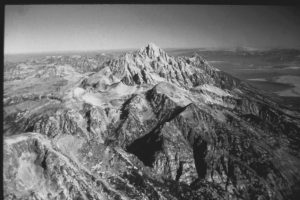Thoughts on the Displacement and Inception of the Teton Fault, Wyoming
Presentation: “Thoughts on the Displacement and Inception of the Teton Fault, Wyoming”, by John O.D. Byrd, of ByrdGEO
October 3rd (Tuesday), 6 p.m., Social half-hour; please join us from 5:30-6:00 to enjoy free soft drinks and appetizers before our talk begins!
Live at the Teton County Library & Via Zoom (online)
The precipitous eastern escarpment of the Teton Range captures the attention of visitors and geologists alike such that they are constantly gazing westward at the mountain front. While the dramatic range front dominates the westward gaze from Jackson Hole, when viewed from Teton Valley the range is expressed as a north-south dome punctuated by the high peaks of the Cathedral Group. These contrasting perspectives and the recent incarnation of the range can be attributed in large part to displacement on the Teton normal fault at the base of the eastern range front.
Several geologic relationships strongly suggest the uplift and present-day topographic expression of the Tetons retains an inherited Laramide (Eocene) component and is not entirely due to displacement on the Teton fault and glaciation. For example, the Eocene Hominy Peak formation (50 Ma) crops out at the northwest end of the Tetons and in the Ricks Basin and Teton Canyon area indicates that the older Mississippian – Devonian strata in that area were at the surface 50 million years ago. Interpretation of a Laramide Teton – Gros Ventre Uplift (TGVU) that included both ranges has been entrenched in the literature for more than 75 years so this is not too surprising of an interpretation. It also does not entirely contradict the range of interpreted ages of the inception, 2 – 12 Ma, and total displacement, 2.1 to 13 km, on the Teton normal fault.
A Laramide age interpretation for the Gros Ventre Range (GVR) has also settled into the literature as a “given”. As a result, deformation of Miocene and younger deposits on the east side of the range has been attributed to displacement on the Teton fault. However, the magnitude, orientation, and variation in deformation of these younger units, in conjunction with the ongoing seismicity in the GVR suggest a much younger, and perhaps ongoing period of uplift that may be independent of the Teton fault. If this is the case, then the age and magnitude of displacement on the Teton fault may be younger and less than previously interpreted.
Topic: Thoughts on the Displacement and Inception of the Teton Fault, Wyoming
Time: Tuesday October 3 rd , 2023 06:00 PM Mountain Time (US and Canada)
Join Zoom Meeting
https://us02web.zoom.us/j/4555651818?pwd=U09ObDNZOEIyZmRtMEtsdUowQnJqdz09
Meeting ID: 455 565 1818
Passcode: 576063

